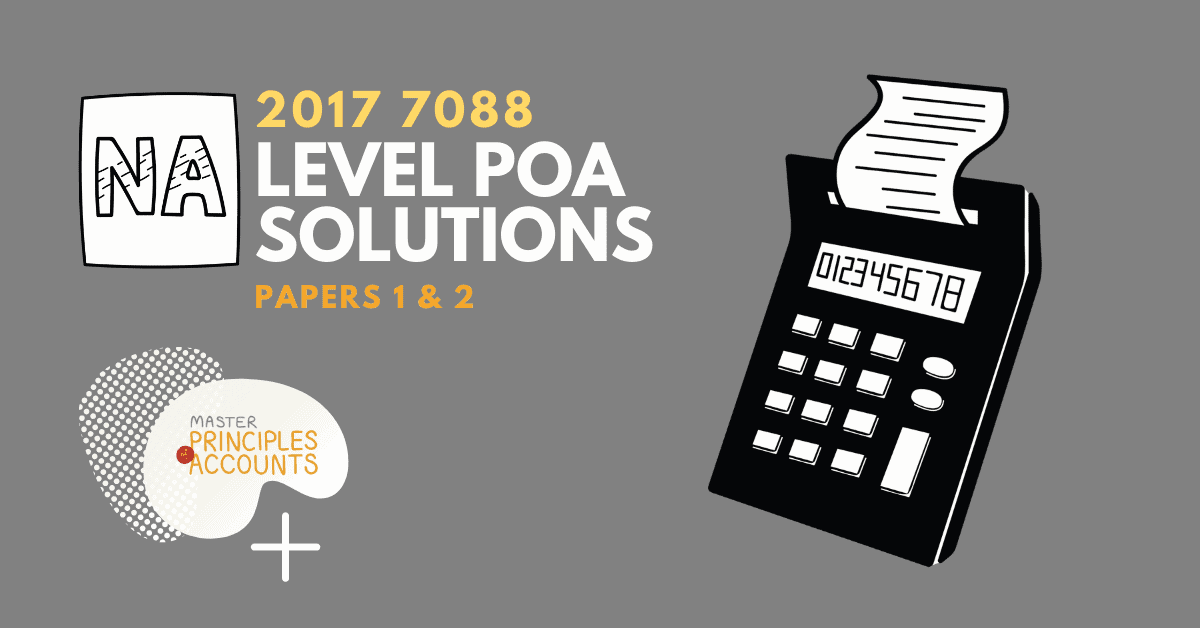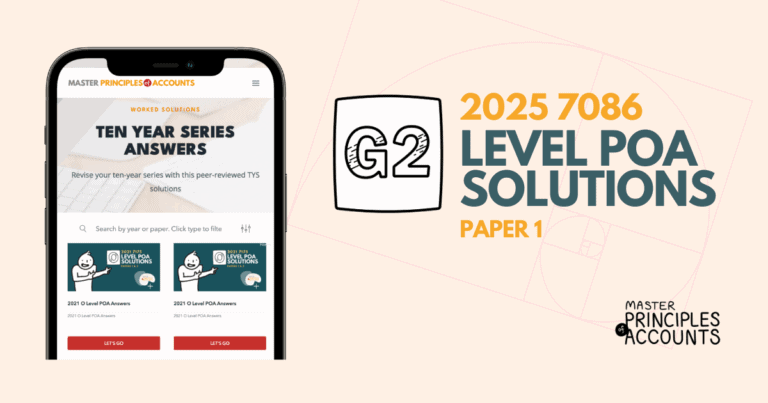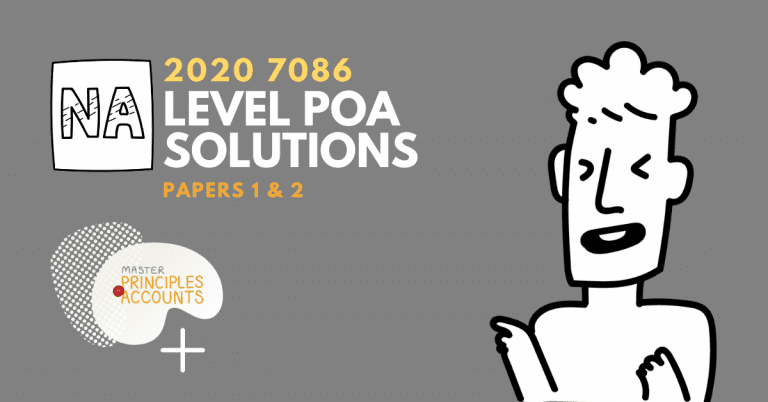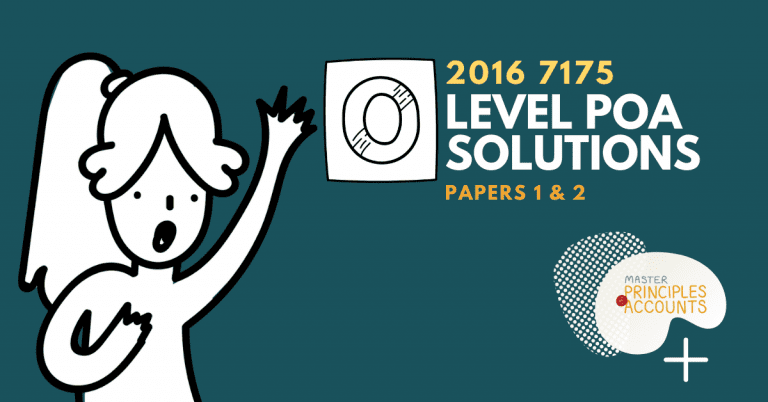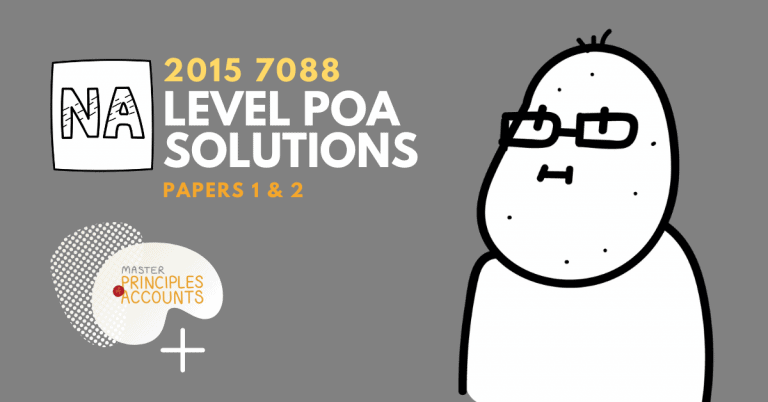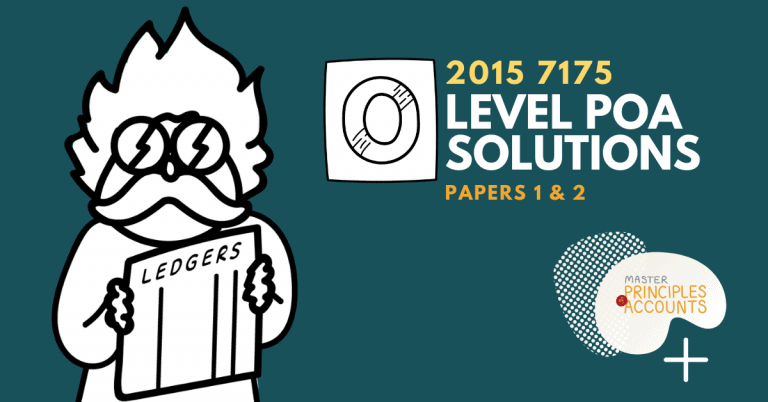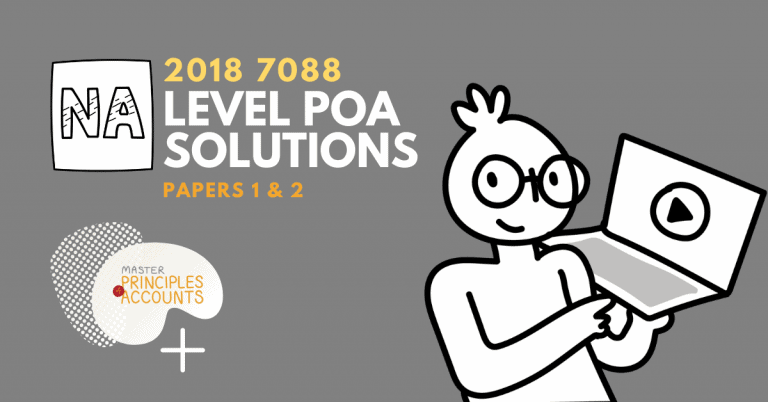2017 N Level POA Answers
Paper 1 :
a) Book-keeping is only the recording of business transactions while accounting is the process of recording, summarising, reporting, analysing and interpretation of financial information.
b) The going-concern theory states that any business should be assumed to operate indefinitely.
c)
| Transaction | Source document | Journal | |
| (i) | Cash sales | Receipt | Cash book |
| (ii) | Credit sales | Invoice | Sales Journal |
| (iii) | Purchases of non-current asset on credit | Invoice | General Journal |
| (iv) | Returns of credit sales | Credit note | Sales returns journal |
| (v) | Cheque payments for credit purchases | Receipt | Purchases Journal |
a)
Umar
Trial balance as at 30 June 2017
| Dr ($) | Cr ($) | |
| Capital | 9 550 | |
| Drawings | 7 225 | |
| Fixtures and fittings | 5 650 | |
| Accumulated depreciation of fixtures and fittings | 1 450 | |
| Cash in hand | 25 | |
| Bank overdraft | 375 | |
| Trade payables | 3 750 | |
| General expenses | 4 955 | |
| Inventory | 470 | |
| Cost of sales | 11 805 | |
| Sales revenue | 15 600 | |
| Sales returns | 595 | |
| 30 725 | 30 725 |
b) 1. To check for arithmetic errors.
2. To aid in the preparation of financial statements.
a)
| Method of depreciation | Workings | Depreciation charge for the year ended 30 September | ||
| 2016 ($) | 2017 ($) | |||
| (i) | Straight-line(using a useful life of 4 ears and a scrap value of $4 000) | (20 000 – 4 000)/4 = 4 000Depreciation charge 2016 = $4 000Depreciation charge 2017 = $4 000 | 4 000 | 4 000 |
| (ii) | Reducing-balance(using a rate of 25%) | Depreciation charge 2016 = 25% x 20 000 = $5 000Depreciation charge 2017 = 25% x (20 000 – 5 000) = $3 750 | 5 000 | 3 750 |
b) Straight-line method.
c) 1. Wear and tear
2. Lapse of time
d) The consistency theory states that when an accounting method is applied to an item, it should be the same throughout all accounting periods.
a) 1. To encourage buyers to bulk buy.
2. To promote brand loyalty.
b) Amount recorded in purchases journal = 3 200 x (100 – 20)% = $2 560
c) Debit
d)
| Overstated | Understated | No effect | |
| Gross profit | ✔ | ||
| Profit for the year | ✔ | ||
| Trade receivables | ✔ | ||
| Cash at bank | ✔ |
Paper 2 :
Malik
Statement of Financial Performance for the year ended 31 May 2017
| $ | $ | |
| Fee income | 30 245 | |
| Less: Expenses | ||
| Rent (5 950 – 550) | 5 400 | |
| Insurance | 2 650 | |
| Printing and stationery (295 + 66) | 361 | |
| General expenses (8 860 – 320) | 8 540 | |
| Motor vehicle expense | 1 675 | |
| Depreciation of fixtures and fittings | 2 450 | |
| Depreciation of motor vehicles | 2 344 | |
| Impairment loss on trade receivables (1 000 – 875) | 125 | 23 545 |
| Profit for the year | 6 700 |
Malik
Statement of Financial Position as at 31 May 2017
| Cost | Accumulated Depreciation | Net Book Value | |
| Assets | $ | $ | $ |
| Non-current assets | |||
| Fixtures and fittings (7 350 + 2 450) | 18 500 | 9 800 | 8 700 |
| Motor vehicles (2 930 + 2 344) | 14 650 | 5 274 | 9 376 |
| Total non-current assets | 33 150 | 15 074 | 18 076 |
| Current assets | |||
| Trade receivables | 2 680 | ||
| Less: Allowance for impairment of trade receivables | (1 000) | ||
| Net trade receivables | 1 680 | ||
| Cash in hand | 85 | ||
| Rent paid in advance | 550 | ||
| Total current assets | 2 315 | ||
| Total assets | 20 391 | ||
| Equity and Liabilities | |||
| Capital (25 500 + 6 700 – (14 380 + 320)) | 17 500 | ||
| Current liabilities | |||
| Trade payable | 1 580 | ||
| Cash at bank (overdraft) | 1 245 | ||
| Stationery payable | 66 | ||
| Total current liabilities | 2 891 | ||
| Total equity and liabilities | 20 391 |
a) Every transaction entered in a journal involves a debit entry in one account and a credit entry in another account. Thus, every transaction should be recorded in at least two accounts as a debit or credit. In a double-entry system, the amounts recorded as debits must be equal to the amounts recorded as credits
b)
| Transaction | Debit | Credit |
| 1 | Cash at bank | Capital |
| 2 | Rent expense | Cash at bank |
| 3 | Inventory | Trade payables – Yin |
| 4 | Fixtures and fittings | Cash in hand |
c)
Banks, government, competitors, investors
a)
Capital
| Date | Particulars | Dr ($) | Cr ($) | Balance |
| 2016 | ||||
| Jul 1 | Balance b/d | 35 500 Cr | ||
| Sep 2 | Office equipment | 125 | ||
| 2017 | ||||
| Jun 30 | Drawings (3 400 + 13 580) | 16 980 | 18 645 Cr | |
| Income summary (28070-18645) | 9 425 | 28 070 Cr | ||
| Jul 1 | Balance b/d | 28 070 Cr | ||
b) Withdrawals of business; resources for the owner’s personal use.
c)
1. Compensating error
2. Error of omission
d)
Journal
| Date | Particulars | Dr ($) | Cr ($) |
| 2017 | |||
| Jun 30 | Discount allowed | 55 | |
| Cost of sales | 55 | ||
| 30 | Advertising expense | 265 | |
| Cash at bank | 265 |
a)
Motor vehicles
| Date | Particulars | Dr ($)+ | Cr ($)- | Balance |
| 2016 | ||||
| Jan 1 | Capital | 8 500 | 8 500 Dr | |
| Sep 1 | Other payable – Ty Motors | 16 800 | 25 300 Dr | |
| 1 | Cash at bank | 150 | 25 450 Dr | |
| 2017 | ||||
| Jan 1 | Balance b/d | 25 450 Dr |
Motor vehicles expense
| Date | Particulars | Dr ($)+ | Cr ($)- | Balance |
| 2016 | ||||
| Jan 1 | Cash at bank | 825 | 825 Dr | |
| Dec 31 | Cash in hand | 253 | 1 078 Dr | |
| Cash at bank | 1 589 | 2 667 Dr | ||
| Prepaid motor vehicle expense (3/15*825) | 165 | 2502 Dr | ||
| Income summary | 2502 | – |
c) To avoid presenting too many insignificant details in financial statements.
a)
Sales revenue
| Date | Particulars | Dr ($)+ | Cr ($)- | Balance |
| 2017 | ||||
| Jul 31 | Trade payable | 81 414 | 81 414 Cr | |
| 31 | Income summary | 81 414 | – |
b)
Sales returns
| Date | Particulars | Dr ($)+ | Cr ($)- | Balance |
| 2017 | ||||
| Jul 31 | Trade payable | 13 480 | 13 480 Dr | |
| 31 | Income summary | 13 480 | – |
c)
Cost of sales
| Date | Particulars | Dr ($)+ | Cr ($)- | Balance |
| 2017 | ||||
| Jul 31 | Inventory | 42 235 | 42 235 Dr | |
| 31 | Inventory (returns) | 2 576 | 39 659 Dr | |
| 31 | Income summary | 39 659 | – |
d)
(81 414 – 13 480 – (42 235 – 2 576)) = $28 275
e) To prepare the statement of financial position.
f) The business and owner are considered separate entities
Have a great weekend!
Caleb

